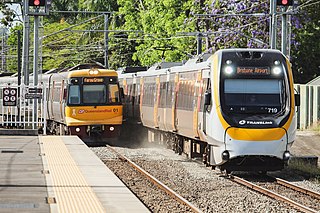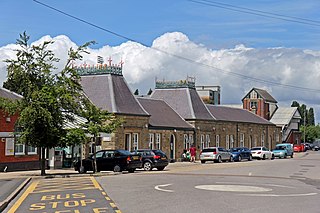
Molong is a small town in the Central West region of New South Wales, Australia, in Cabonne Shire.

Rail transport in Australia is a component of the Australian transport system. It is to a large extent state-based. As of 2018, the Australian rail network consists of a total of 36,064 kilometres (22,409 mi) of track built to three major track gauges:14,814 kilometres (9,205 mi) of standard gauge ), 15,625 kilometres (9,709 mi) of broad gauge, and 4,225 kilometres (2,625 mi) of narrow gauge lines. Additionally, about 1,400 kilometres (870 mi) of 610 mm / 2 ft gauge lines support the sugar-cane industry.

Rail transport in Victoria, Australia, is provided by a number of railway operators who operate over the government-owned railway lines. The network consists of 2,357 km of Victorian broad gauge lines, and 1,912 km of standard gauge freight and interstate lines; the latter increasing with gauge conversion of the former. Historically, a few experimental 762 mm gauge lines were built, along with various private logging, mining and industrial railways. The rail network radiates from the state capital, Melbourne, with main interstate links to Sydney and to Adelaide, as well as major lines running to regional centres, upgraded as part of the Regional Fast Rail project.

The Vale of Glamorgan Line is a commuter railway line in Wales, running through the Vale of Glamorgan from Barry to Bridgend, via Rhoose and Llantwit Major.

Llanelli railway station is the railway station serving the town of Llanelli, Carmarthenshire, Wales. It is located on the West Wales line and the Heart of Wales line 11+1⁄4 miles (18.1 km) west of Swansea by rail. The station and the majority of trains calling are operated by Transport for Wales.

The Dry Creek–Port Adelaide railway line is an eight-kilometre east–west line running through Adelaide's north-western suburbs. The line is managed by the Australian Rail Track Corporation (ARTC) and is an important link between Port Adelaide, Pelican Point and the main interstate rail routes which link Adelaide with Melbourne, Perth, Darwin and Sydney. Prior to 1988, a limited local passenger service operated, stopping at five intermediate stations along the line. Since May 1988, the line has been freight-only.
Australian railway signalling varies between the states of Australia as each railway was established under the different colonial governments with separate legislation. As with the notorious situation of having different gauges, there are differing signal systems.New South Wales signalling systems generally follow British precepts, however American influence has increased somewhat since the 1990s. The Victorian Railways use Speed Signalling. This can cause confusion where the systems meet.

Wrexham General railway station is a main line railway station and the main railway station serving Wrexham, north-east Wales. It is currently operated by Transport for Wales, but services are also provided by Avanti West Coast who operate a service to London Euston. Until January 2011 Wrexham & Shropshire also operated from here to London Marylebone.

Southern Shorthaul Railroad is an Australian rail freight services operator in New South Wales and Victoria. They also provide workshop services such as rolling stock manufacturing and wagon and locomotive maintenance.
The Main Western Railway is a major railway in New South Wales, Australia. It runs through the Blue Mountains, Central West, North West Slopes and the Far West regions. It is 825 kilometres (513 mi) with 484 kilometres (301 mi) operational & 341 kilometres (212 mi) under construction & repairs.

The Broken Hill railway line is now part of the transcontinental railway from Sydney to Perth.

The Robinvale railway line is a freight only country railway line in north-western Victoria, Australia. The line branches from the Mildura line at Dunolly, and at Inglewood the Eaglehawk – Inglewood line connects with the Piangil line outside Bendigo. The parallel Kulwin line junctions from the Robinvale line at Korong Vale then continues northward.

The Eugowra railway line is a closed railway line in New South Wales, Australia. The 80 km (50 mi) branch line joins the Blayney-Demondrille line at Cowra.

The wheatbelt railway lines of Western Australia were, in most cases, a network of railway lines in Western Australia that primarily served the Wheatbelt region.

Dubbo railway station is a heritage-listed railway station and bus interchange located on the Main Western line in Dubbo in the Dubbo Regional Council local government area of New South Wales, Australia. The station serves the city of Dubbo and was opened on 1 February 1881. The station is also known as Dubbo Railway Station and yard group. The property was added to the New South Wales State Heritage Register on 2 April 1999. The station and associated yards were designed by the office of the Engineer-in-Chief of the NSW Government Railways, under the direction of John Whitton.
Burrawong Parish is a civil parish of Gordon County, New South Wales, a Cadastral divisions of New South Wales.
Burgoon Parish is a civil parish of Gordon County, New South Wales, a Cadastral divisions of New South Wales.
The Gap Parish is a civil parish of Gordon County, New South Wales, a Cadastral divisions of New South Wales.

Buckinbah Parish is a civil parish of Gordon County, New South Wales, a Cadastral divisions of New South Wales.

Bourke railway station is a heritage-listed former railway station in Bourke, in the Far West region of New South Wales. The station opened in 1885 as the terminus of the Main Western line. Passenger trains to Bourke ceased in 1975 when the rail service beyond Dubbo was replaced by road coaches. NSW TrainLink continues to serve the station precinct by coach. The property belongs to the Country Regional Network (CRN), which is owned by Transport for NSW and operated by John Holland Rail.














